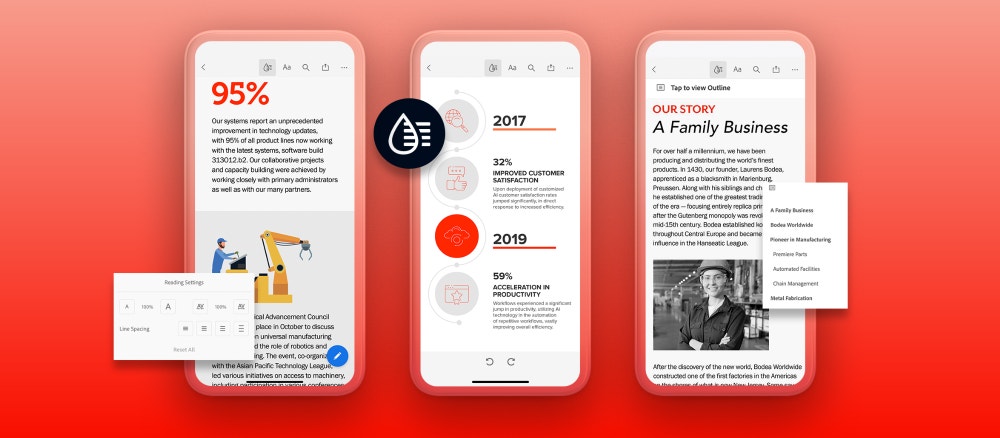 Since the pandemic has put a halt on face-to-face interactions, entire industries turned to virtual ways of working. As a result, digital documents have become a centerpiece for how we communicate, collaborate, and transact. Hence, to no surprise, the demand for Adobe’s Document Cloud product and services has been skyrocketing: Adobe Sign usage has risen more than 200% and Acrobat DC monthly active users have more than doubled in 2020, reflecting the growing role PDF plays across all segments of the economy. In fact, it is estimated that there are currently more than 2.5 trillion PDFs in the world today.
Since the pandemic has put a halt on face-to-face interactions, entire industries turned to virtual ways of working. As a result, digital documents have become a centerpiece for how we communicate, collaborate, and transact. Hence, to no surprise, the demand for Adobe’s Document Cloud product and services has been skyrocketing: Adobe Sign usage has risen more than 200% and Acrobat DC monthly active users have more than doubled in 2020, reflecting the growing role PDF plays across all segments of the economy. In fact, it is estimated that there are currently more than 2.5 trillion PDFs in the world today.
As more people rely on digital services for their work and personal lives, Adobe, the inventor of PDF, is manifesting the future of PDF through Liquid Mode. Using Adobe Sensei, Adobe’s proprietary AI, the feature will deliver a breakthrough reading experience on mobile to bring greater convenience to increasingly mobile workers.
According to Adobe, Liquid Mode is the first step in a multi-year vision to fundamentally change the way people consume digital documents, and how organizations can extract document intelligence to gain a competitive advantage. Leveraging the power of Adobe Sensei to understand the structure of PDFs, Adobe has begun to reimagine how people read and interact with digital documents, starting with reinventing mobile productivity.
With the push of a button of Liquid Mode in Adobe Acrobat Reader, the feature will automatically reformat text, images, and tables for quick navigation and consumption on small screens. Powered by Adobe Sensei, Liquid Mode uses AI and machine learning in the background to understand and identify parts of a PDF, like headings, paragraphs, images, lists, tables, and more. It also attempts to understand the hierarchy and order of those parts to reformat a static PDF into a more dynamic and customizable experience.
Liquid Mode simultaneously creates an intelligent outline, collapsible and expandable sections, and searchable text for quick navigation. Users can even tailor font size and spacing between words, characters, and lines to suit their specific reading preferences. This is especially useful for those who may see the text as too small, squished together, tight, or jumbled. With Liquid Mode, pinching and zooming are no longer necessary. Words are resizable and reflowable, images are tappable and expandable, and tables are responsive.
The main features of Liquid Mode that you can look forward to are:
- The use of AI and machine learning in Liquid Mode
Powered by Adobe Sensei, the use of AI and machine learning in the background identifies different parts of the PDF such as the headings and images. By understanding the hierarchy and order of those parts, it enables Liquid Mode to reformat a static PDF into a more dynamic and customizable experience - Simultaneous creation of an intelligent outline, dynamic sections, and searchable text for quick navigation
Pinching and zooming are no longer necessary as images are now tappable and expandable and tables are responsive. Additionally, words can be tailored to suit the user’s font size and spacing preferences, making it suitable for all kinds of users.
Adobe is relentlessly working on the future of PDF and its long-term vision is centered around bringing more Adobe Sensei technology into all of document products and services: imagine using AI to replace months of intensive document research with a quick query that cross-references millions of PDFs in your organization at once; or uncovering groundbreaking medical insights from PDF data spread across millions of scientific research reports, medical records, or academic studies. Unleashing this technology to state and local governments could also significantly improve coordination and collaboration across disparate agencies.
Adobe’s mission is clear, namely delivering exceptional digital experiences. For three decades now the company is leading in this field of business: from the introduction of PDF in the early 1990’s, to unleashing it as an open standard in 2008, to the debut of Liquid Mode today. So, we can expect Adobe to continue riding on a huge wave of success in the future.
By MediaBUZZ


